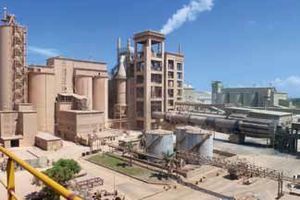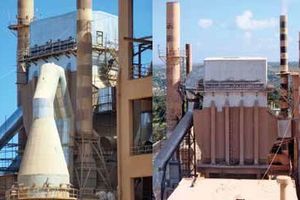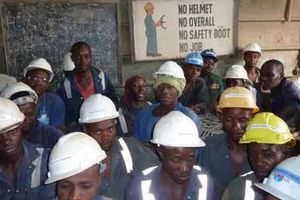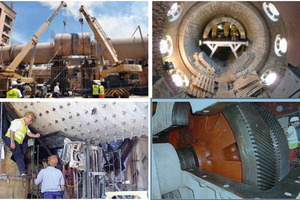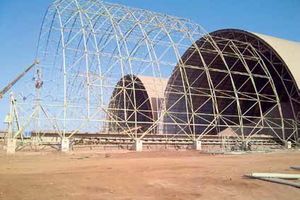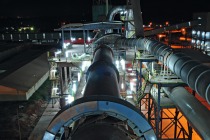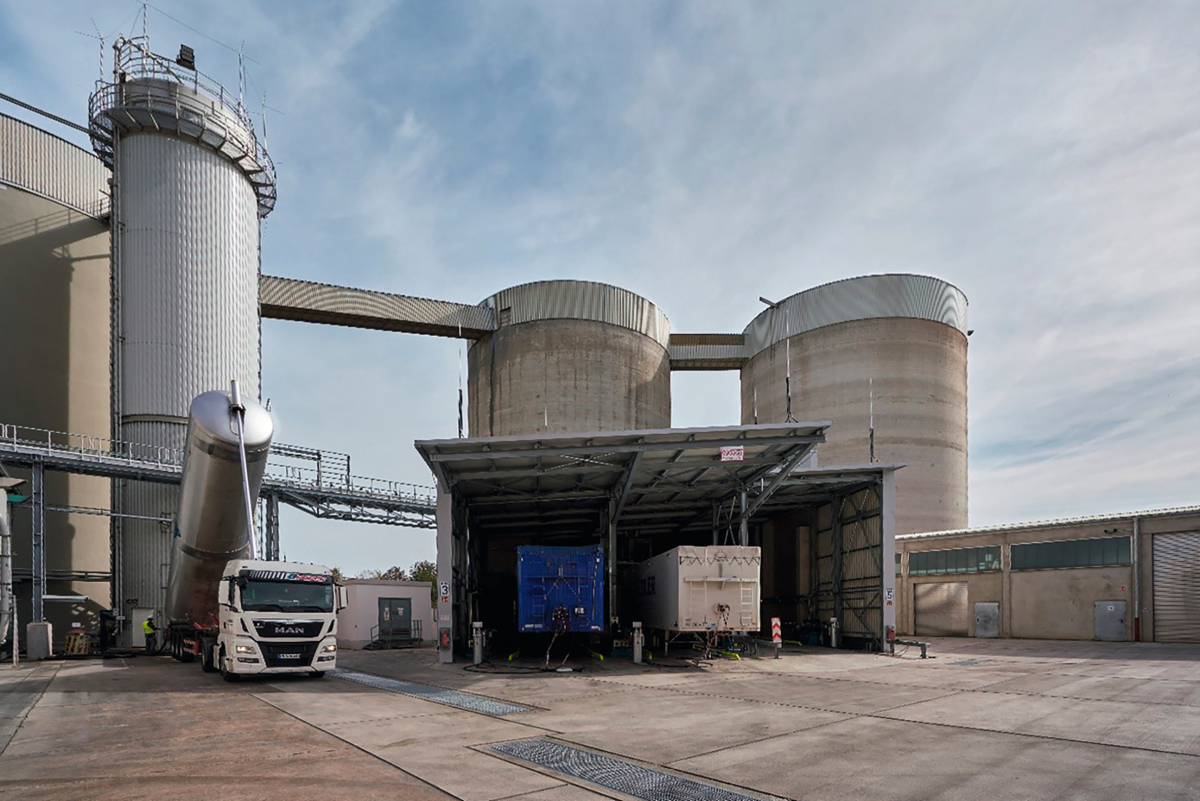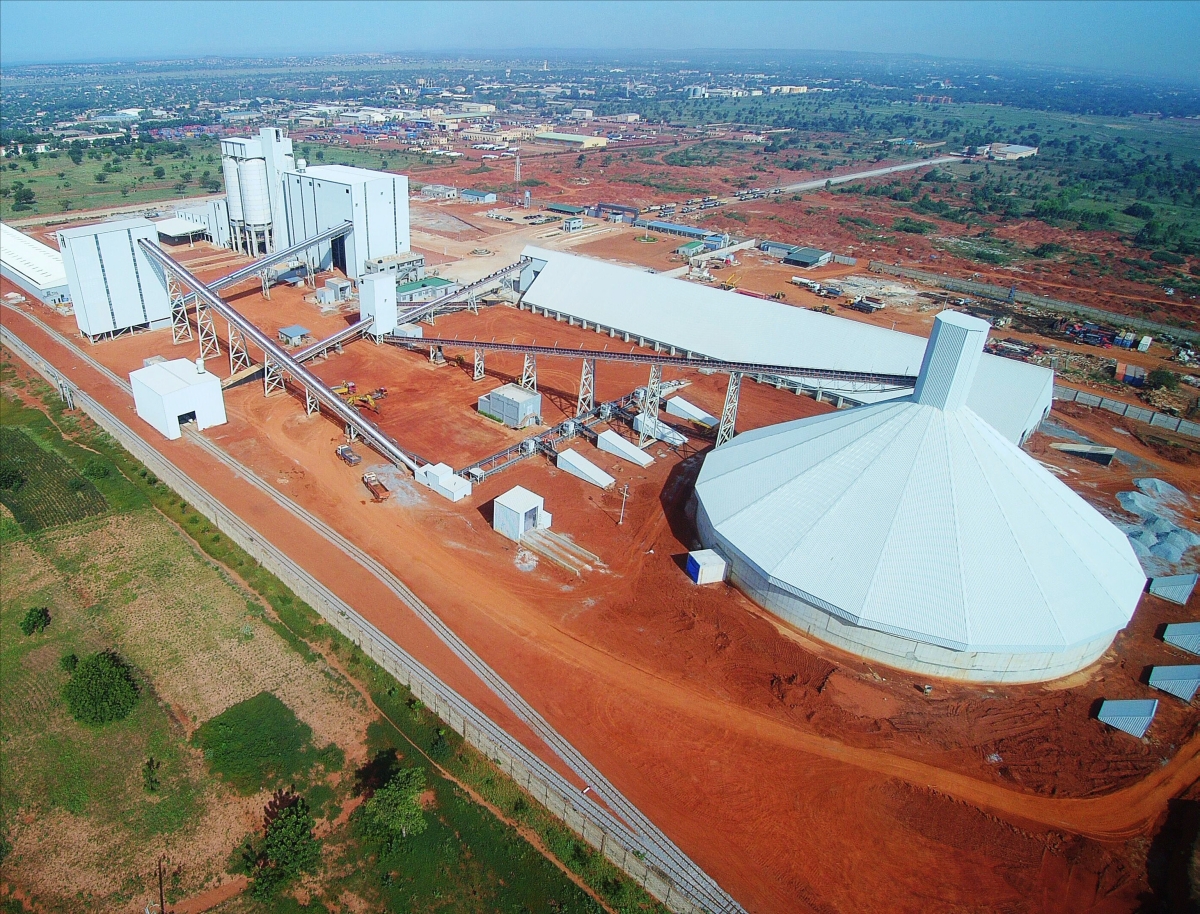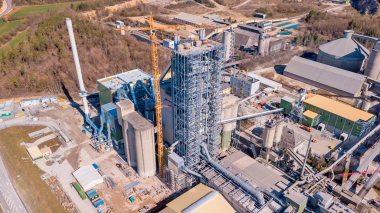Kiln rehabilitation in Tanzania
1 Introduction
In spring 2011, the Intercem Group with offices in Zurich/Switzerland and Oelde/Germany received the contract to modernize the cement plant Wazo Hill of the Tanzania Portland Cement Company (TPCC) which lies about 20 km north of Dar es Salaam/Tanzania (Fig. 1). Since 2005, TPCC belongs to the HeidelbergCement Group. The foundation for the factory was laid in 1962, production of cement began 1966. Over the years TPCC increased the discharge rate by commissioning two additional kiln lines. Their latest was erected in the late 1970s under the leadership of FLSmidth and was built mainly from their components. In 1979 this 3rd kiln line started production.
The cement plant Wazo Hill processes fossil reef limestone from the Tertiary era, which is quarried in the homonymous neighboring hills. Rising up to a height of about 100 m above sea level, they are the highest fossil reef on the coast of Tanzania – and one of the largest limestone reserves of the country. For the exploitation of individual areas the lateritic weathered topsoil layer was bulldozed away and dumped at the side of the quarry for use in later land restoration.
Due to the rising demand for cement in East Africa, it was decided on an extension of the plant including an additional kiln line, which was commissioned in 2008. The kiln line 3 had been put out of service at this time.
According to information in the Global Cement Plant Database, the Wazo Hill factory mainly produces Portland Composite Cement. The capacities in clinker and cement amount to 1400 Mta and 1120 Mta respectively. The process heat is produced from oil and gas.
2 The order
Through the rehabilitation of the kiln line No. 3 and its periphery, the clinker capacity of the plant should be increased by about 330,000 t, beginning with the 2nd quarter of 2012. Furthermore, the clinker and cement quality should be improved and maintained.
The specifications of the contract were extensive and initially covered more than a dozen sections of the plant. Some components could not be fully inspected prior to the contract and should be examined and assessed in more detail during the project execution.
The Intercem Group was appointed to perform the following supplies and services at EPC basis:
Local dimensions recording, i.e. with a 3-D scanner
Inspections / assessments/reviews
Engineering (mechanical – electrical – civil)
Deliveries of all system components
Transport
Foundation work
Disassembly and assembly work
Repairs and overhauls
Commissioning
Among others, optimizations should be performed in the following investment areas:
Optimization of the rotary kiln (dimensions Ø 3,95 x 58 m ) with new kiln inlet seal, new furnace shots, completely new refractory lining and overhaul of roller bearings, overhaul of the drive train and the main gearbox
Revision of satellite cooling pipes including the installation of replacement parts as well as the refractory lining
Conversion of the furnace filter from ESP to bag filter based on a CFD (Comtutational Fluid Dynamics) flow analysis. This base is the constructive outcome after reconstruction of the ESP filter bag filter (Fig. 2)
Complete overhaul of the heat exchanger (cyclones, dip tubes, pipes, valves, sensors, refractories, compensators )
New gas analysis for furnace and heat exchanger (kiln inlet probe and exhaust-gas probe)
Expansion of the raw material warehouse, including stackers and reclaimers
Establishment of a “Raw material preparation station” with X-ray analysis and state-of-the-art extraction technique for some very wet and sticky material (Fig. 3)
New weighing and extraction system in the raw material grinding plant
Overhaul of raw meal separator and ball mill
Optimization of conveying units in the raw material grinding plant
Overhaul of the raw meal silos with new parts of the system
New pneumatic conveying of raw meal on the heat exchanger including cyclone separator before the raw meal entry in the heat exchange process
New clinker transport (replacing the steel pan conveyors and overhaul of the clinker crusher)
Completely new installation of electrical engineering and automation
3 Requirements
During the feasibility study before accepting the order, Intercem found out that no design drawings (“as-built drawings”) of the plant were available in sufficient number, and therefore no authentic documents for exact planning of the new parts existed. This shortcoming, however, could be compensated by a 3-D scanning of all areas for remodeling the existing plant in Oelde. This highly accurate recording method using special cameras was thus the basis for a high accuracy in planning the configured system, meaning a high degree of mounting precision for the executing labourers in Tanzania. As a direct result planning mistakes could be avoided, thus complying with the project’s estimated times, which often causes an explosion in costs.
Even with this approach, the individual local characteristics of each country of operation are hardly taken into consideration, however, in the case of the project presented, they will be mentioned in more detail below.
From the technical side, it was planned to bring the plant to the state-of-the-art. Most of the existing plant components and “core components” should be used again in order to keep the total investment low. New components were necessary only in areas where it was not expedient to implement modifications. Engineering, disassembly, overhaul/modification of existing components, supplies, site installation and commissioning, all are to be planned and carried out by Intercem.
As a further requirement, HeidelbergCement as the owner of the Wazo Hill plant had prescribed settlement of the project under the in-house safety requirements. In spite of these at first sight extremely difficult conditions by African standards – or possibly because of them anyway, during the entire construction phase not a single accident occurred (Fig. 4).
4 Project-specific features
The site project management in Wazo Hill faced again and again seemingly insurmountable obstacles that arose due to local conditions. The recruitment of qualified local staff turned out to be a very big challenge. Theft of building materials and tools, which is almost mandatory in Third World countries as well as arbitrary public authorities as well as serious events, were just some of the extraordinary pressures, of which only a few are mentioned here:
Suitable cranes for mounting were hardly available – and if so, very often failed due to technical problems, which meant delays.
Because of the completely congested regional power grid, multiple daily power outages occurred, so that was not possible to comply with the regular daily working hours. This resulted in an increased downtime = delay.
Customs clearance of cargo ships usually lasted five weeks. And even air cargo was only released after 3-4 weeks.
The ship with the tool containers arrived after a delay of eight weeks, as it had to go to Somalia first because of a famine there, to unload food. The five-week long customs clearance could not be reduced in this case – which increased the delay to 13 weeks.
Locally manufactured simple steel weldments were not delivered in accordance with the contractually agreed dates (delay).
Onsite stored goods and equipment kept disappearing without a trace, although the Security Service had its quarters immediately adjacent to the depot.
Unknown persons dismantled and stole power cables, that were already installed and standing under medium voltage.
Local installation personnel did not meet the expectations.
Some areas of the specifications could not be verified, such as the state of the main transmission gears, which could not be opened prior to the contract. The condition assessment and overhaul measures had to be done during the settlement in coordination and definition with the customer. Here it was typical “black box” trades.
Extremely challenging and penalised schedule.
The mechanical and electrical installation was carried out mainly with local personnel. Up to 260 Tanzanian workers were employed at peak times on the site, which were directed and controlled by 25 Intercem foremen and supervisors. A permanently located on-site construction management team, consisting of 3-5 Intercem engineers depending on the construction phase was responsible for the coordination of the project .
The logistical and administrative problems continued through the commissioning phase. Poor water quality, inadequate air supply, a small amount of cooling water and the daily “power cuts” led to delays, so that the first clinker was produced a few weeks late in July 2012. Despite the difficult circumstances it was possible for the Intercem specialists to bring the system to a stable operation in a relatively short time, so that the retreaded kiln line (Fig. 5) could be handed over to the customer with an FAC (Final Acceptance Certificate) in December 2012.
5 Special tools
Due to the lack of “as-built drawings” the original situation of many plant parts was recorded with a special 3-D scanner. This resulted in a very high degree of planning (Fig. 6) and ensured accuracy, which in turn was reflected in flawless plans. This became clear during assembly, as delays and additional costs resulting from design errors did not occur at Wazo Hill.
6 Conclusion and project appraisal
Despite the difficult and sometimes almost intolerable circumstances, the plant could be brought into stable operation. All technical and logistical difficulties were overcome without accidents and with only very minor delays. The contractually agreed warranty (including throughput, specific consumption, oxygen content) was complied with as well as the FIDIC guidelines as a basis contract. During the operating period of 18 months, no major failures of plant components were recorded.
Through the establishment of the subsidiary Intercem Tanzania Ltd., the use of local professionals as well as the provision of installation materials etc. were coordinated properly. The good and very close cooperation between the project teams of TPCC/HeidelbergCement and Intercem made it possible to realize the project together successfully.
By installing the raw material preparation and the X-ray analyzer, a significantly improvement of clinker and cement quality was possible. Furthermore, the homogenization in the extended raw material section (Fig. 7) has resulted in constant production conditions in the heat exchangers and the rotary kiln. Altogether, this has increased the availability of the entire system.
7 About Intercem
Intercem Cement AG belongs to the Swiss Intercem Holding and consists of four separate companies: The actual Intercem Cement AG, headquartered in Zurich/Switzerland, Intercem Tanzania Ltd. in Dar es Salaam/Tanzania, and Intercem Engineering GmbH and Intercem Installation GmbH in Oelde/Germany. At the headquarters the areas of coordination, contracting, finance, controlling and accounting procedures and the commercial contract management are located.
The company covers with its duties portfolio nearly 100 % of all activities of the international cement industry – from raw material preparation to packaging system. The focus lies on used and refurbished components, projects with used, refurbished and new components as well as work plans or improvements with new components. The company philosophy is based on the maxim: “fast – fair – flexible”.
Intercem Tanzania Ltd. in Dar es Salaam is a subsidiary established specifically for the east African country, focused on all work required for the modernization of the Wazo Hill (Twiga) cement plant of the Tanzania Portland Cement Company (TPCC).The tasks included primarily the portfolio offered by Intercem in Oelde because this can usually be implemented better by the proximity to customers and the associated greater influence on the country-specific characteristics than from Germany.
The technical order is handled by the two German subsidiaries Intercem Engineering GmbH and Intercem installation GmbH, which have their headquarters in the Westphalian Oelde. They deal mainly with all plant-specific work. This entails on the one hand the decommissioning of facilities and equipment, repair and maintenance, modifications, installation supervision, management and commissioning, technical and visual rehabilitation and the construction of steel structures, and on the other hand project management and system planning, engineering, training and services, feasibility studies, advice and after-sales services.
In Oelde, Intercem employs approximately 40 people, of which a considerable portion is constantly travelling around the globe to manage and monitor projects.
A step particularly emphasized in the portfolio of Intercem is the evaluation of existing systems by a special 3-D laser scanning method for a so-called “as-built-documentation”. This process provides a unique feature for Intercem.1 Introduction
In spring 2011, the Intercem Group with offices in Zurich/Switzerland and Oelde/Germany received the contract to modernize the cement plant Wazo Hill of the Tanzania Portland Cement Company (TPCC) which lies about 20 km north of Dar es Salaam/Tanzania (Fig. 1). Since 2005, TPCC belongs to the HeidelbergCement Group. The foundation for the factory was laid in 1962, production of cement began 1966. Over the years TPCC increased the discharge rate by commissioning two additional kiln lines. Their latest was erected in the late 1970s under the leadership of FLSmidth and was built mainly from their components. In 1979 this 3rd kiln line started production.
The cement plant Wazo Hill processes fossil reef limestone from the Tertiary era, which is quarried in the homonymous neighboring hills. Rising up to a height of about 100 m above sea level, they are the highest fossil reef on the coast of Tanzania – and one of the largest limestone reserves of the country. For the exploitation of individual areas the lateritic weathered topsoil layer was bulldozed away and dumped at the side of the quarry for use in later land restoration.
Due to the rising demand for cement in East Africa, it was decided on an extension of the plant including an additional kiln line, which was commissioned in 2008. The kiln line 3 had been put out of service at this time.
According to information in the Global Cement Plant Database, the Wazo Hill factory mainly produces Portland Composite Cement. The capacities in clinker and cement amount to 1400 Mta and 1120 Mta respectively. The process heat is produced from oil and gas.
2 The order
Through the rehabilitation of the kiln line No. 3 and its periphery, the clinker capacity of the plant should be increased by about 330,000 t, beginning with the 2nd quarter of 2012. Furthermore, the clinker and cement quality should be improved and maintained.
The specifications of the contract were extensive and initially covered more than a dozen sections of the plant. Some components could not be fully inspected prior to the contract and should be examined and assessed in more detail during the project execution.
The Intercem Group was appointed to perform the following supplies and services at EPC basis:
Local dimensions recording, i.e. with a 3-D scanner
Inspections / assessments/reviews
Engineering (mechanical – electrical – civil)
Deliveries of all system components
Transport
Foundation work
Disassembly and assembly work
Repairs and overhauls
Commissioning
Among others, optimizations should be performed in the following investment areas:
Optimization of the rotary kiln (dimensions Ø 3,95 x 58 m ) with new kiln inlet seal, new furnace shots, completely new refractory lining and overhaul of roller bearings, overhaul of the drive train and the main gearbox
Revision of satellite cooling pipes including the installation of replacement parts as well as the refractory lining
Conversion of the furnace filter from ESP to bag filter based on a CFD (Comtutational Fluid Dynamics) flow analysis. This base is the constructive outcome after reconstruction of the ESP filter bag filter (Fig. 2)
Complete overhaul of the heat exchanger (cyclones, dip tubes, pipes, valves, sensors, refractories, compensators )
New gas analysis for furnace and heat exchanger (kiln inlet probe and exhaust-gas probe)
Expansion of the raw material warehouse, including stackers and reclaimers
Establishment of a “Raw material preparation station” with X-ray analysis and state-of-the-art extraction technique for some very wet and sticky material (Fig. 3)
New weighing and extraction system in the raw material grinding plant
Overhaul of raw meal separator and ball mill
Optimization of conveying units in the raw material grinding plant
Overhaul of the raw meal silos with new parts of the system
New pneumatic conveying of raw meal on the heat exchanger including cyclone separator before the raw meal entry in the heat exchange process
New clinker transport (replacing the steel pan conveyors and overhaul of the clinker crusher)
Completely new installation of electrical engineering and automation
3 Requirements
During the feasibility study before accepting the order, Intercem found out that no design drawings (“as-built drawings”) of the plant were available in sufficient number, and therefore no authentic documents for exact planning of the new parts existed. This shortcoming, however, could be compensated by a 3-D scanning of all areas for remodeling the existing plant in Oelde. This highly accurate recording method using special cameras was thus the basis for a high accuracy in planning the configured system, meaning a high degree of mounting precision for the executing labourers in Tanzania. As a direct result planning mistakes could be avoided, thus complying with the project’s estimated times, which often causes an explosion in costs.
Even with this approach, the individual local characteristics of each country of operation are hardly taken into consideration, however, in the case of the project presented, they will be mentioned in more detail below.
From the technical side, it was planned to bring the plant to the state-of-the-art. Most of the existing plant components and “core components” should be used again in order to keep the total investment low. New components were necessary only in areas where it was not expedient to implement modifications. Engineering, disassembly, overhaul/modification of existing components, supplies, site installation and commissioning, all are to be planned and carried out by Intercem.
As a further requirement, HeidelbergCement as the owner of the Wazo Hill plant had prescribed settlement of the project under the in-house safety requirements. In spite of these at first sight extremely difficult conditions by African standards – or possibly because of them anyway, during the entire construction phase not a single accident occurred (Fig. 4).
4 Project-specific features
The site project management in Wazo Hill faced again and again seemingly insurmountable obstacles that arose due to local conditions. The recruitment of qualified local staff turned out to be a very big challenge. Theft of building materials and tools, which is almost mandatory in Third World countries as well as arbitrary public authorities as well as serious events, were just some of the extraordinary pressures, of which only a few are mentioned here:
Suitable cranes for mounting were hardly available – and if so, very often failed due to technical problems, which meant delays.
Because of the completely congested regional power grid, multiple daily power outages occurred, so that was not possible to comply with the regular daily working hours. This resulted in an increased downtime = delay.
Customs clearance of cargo ships usually lasted five weeks. And even air cargo was only released after 3-4 weeks.
The ship with the tool containers arrived after a delay of eight weeks, as it had to go to Somalia first because of a famine there, to unload food. The five-week long customs clearance could not be reduced in this case – which increased the delay to 13 weeks.
Locally manufactured simple steel weldments were not delivered in accordance with the contractually agreed dates (delay).
Onsite stored goods and equipment kept disappearing without a trace, although the Security Service had its quarters immediately adjacent to the depot.
Unknown persons dismantled and stole power cables, that were already installed and standing under medium voltage.
Local installation personnel did not meet the expectations.
Some areas of the specifications could not be verified, such as the state of the main transmission gears, which could not be opened prior to the contract. The condition assessment and overhaul measures had to be done during the settlement in coordination and definition with the customer. Here it was typical “black box” trades.
Extremely challenging and penalised schedule.
The mechanical and electrical installation was carried out mainly with local personnel. Up to 260 Tanzanian workers were employed at peak times on the site, which were directed and controlled by 25 Intercem foremen and supervisors. A permanently located on-site construction management team, consisting of 3-5 Intercem engineers depending on the construction phase was responsible for the coordination of the project .
The logistical and administrative problems continued through the commissioning phase. Poor water quality, inadequate air supply, a small amount of cooling water and the daily “power cuts” led to delays, so that the first clinker was produced a few weeks late in July 2012. Despite the difficult circumstances it was possible for the Intercem specialists to bring the system to a stable operation in a relatively short time, so that the retreaded kiln line (Fig. 5) could be handed over to the customer with an FAC (Final Acceptance Certificate) in December 2012.
5 Special tools
Due to the lack of “as-built drawings” the original situation of many plant parts was recorded with a special 3-D scanner. This resulted in a very high degree of planning (Fig. 6) and ensured accuracy, which in turn was reflected in flawless plans. This became clear during assembly, as delays and additional costs resulting from design errors did not occur at Wazo Hill.
6 Conclusion and project appraisal
Despite the difficult and sometimes almost intolerable circumstances, the plant could be brought into stable operation. All technical and logistical difficulties were overcome without accidents and with only very minor delays. The contractually agreed warranty (including throughput, specific consumption, oxygen content) was complied with as well as the FIDIC guidelines as a basis contract. During the operating period of 18 months, no major failures of plant components were recorded.
Through the establishment of the subsidiary Intercem Tanzania Ltd., the use of local professionals as well as the provision of installation materials etc. were coordinated properly. The good and very close cooperation between the project teams of TPCC/HeidelbergCement and Intercem made it possible to realize the project together successfully.
By installing the raw material preparation and the X-ray analyzer, a significantly improvement of clinker and cement quality was possible. Furthermore, the homogenization in the extended raw material section (Fig. 7) has resulted in constant production conditions in the heat exchangers and the rotary kiln. Altogether, this has increased the availability of the entire system.
7 About Intercem
Intercem Cement AG belongs to the Swiss Intercem Holding and consists of four separate companies: The actual Intercem Cement AG, headquartered in Zurich/Switzerland, Intercem Tanzania Ltd. in Dar es Salaam/Tanzania, and Intercem Engineering GmbH and Intercem Installation GmbH in Oelde/Germany. At the headquarters the areas of coordination, contracting, finance, controlling and accounting procedures and the commercial contract management are located.
The company covers with its duties portfolio nearly 100 % of all activities of the international cement industry – from raw material preparation to packaging system. The focus lies on used and refurbished components, projects with used, refurbished and new components as well as work plans or improvements with new components. The company philosophy is based on the maxim: “fast – fair – flexible”.
Intercem Tanzania Ltd. in Dar es Salaam is a subsidiary established specifically for the east African country, focused on all work required for the modernization of the Wazo Hill (Twiga) cement plant of the Tanzania Portland Cement Company (TPCC).The tasks included primarily the portfolio offered by Intercem in Oelde because this can usually be implemented better by the proximity to customers and the associated greater influence on the country-specific characteristics than from Germany.
The technical order is handled by the two German subsidiaries Intercem Engineering GmbH and Intercem installation GmbH, which have their headquarters in the Westphalian Oelde. They deal mainly with all plant-specific work. This entails on the one hand the decommissioning of facilities and equipment, repair and maintenance, modifications, installation supervision, management and commissioning, technical and visual rehabilitation and the construction of steel structures, and on the other hand project management and system planning, engineering, training and services, feasibility studies, advice and after-sales services.
In Oelde, Intercem employs approximately 40 people, of which a considerable portion is constantly travelling around the globe to manage and monitor projects.
A step particularly emphasized in the portfolio of Intercem is the evaluation of existing systems by a special 3-D laser scanning method for a so-called “as-built-documentation”. This process provides a unique feature for Intercem.

